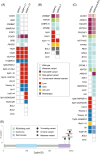The genomic landscape of transformed splenic diffuse red pulp small B-cell lymphoma
- PMID: 39415899
- PMCID: PMC11474344
- DOI: 10.1002/jha2.1018
The genomic landscape of transformed splenic diffuse red pulp small B-cell lymphoma
Abstract
The genetic landscape underlying the transformation of splenic diffuse red pulp small B-cell lymphoma (SDRPL) is not well understood. The present study aimed to unravel the genomic alterations involved in the progression and transformation of SDRPL. We performed genetic studies on both SDRPL and subsequent or synchronous diffuse large B cell lymphoma (DLBCL) samples in three SDRPL patients who eventually developed DLBCL. Our findings revealed that SDRPL cases progressing to DLBCL acquired genomic alterations in genes related to the cell cycle (CDKN2A/B, TP53, MYC and CCND3) and B cell development (BCL6).
Keywords: B‐cell developement; cell cycle; clonal relationship; genetic alterations; histologic transformation; splenic diffuse red pulp small B‐cell lymphoma.
© 2024 The Author(s). eJHaem published by British Society for Haematology and John Wiley & Sons Ltd.
Conflict of interest statement
Elias Campo has been a consultant for GenMab, and Takeda; has received research support from AstraZeneca; received honoraria from Janssen, EUSPharma, Takeda and Roche for speaking at educational activities; and is an inventor on a Lymphoma and Leukemia Molecular Profiling Project patent ‘Method for subtyping lymphoma subtypes by means of expression profiling’ (PCT/US2014/64161) and a bioinformatic tool (IgCaller) licenced to Diagnostic Longwood. Armando López‐Guillermo. served on the advisory board of Roche, Celgene, Novartis and Gilead/Kite, and received grants from Celgene and Gilead/Kite. Ferran Nadeu has received honoraria from Janssen, AbbVie, AstraZeneca and SOPHiA GENETICS for speaking at educational activities; has received research support from Gilead; and has licensed the use of the protected IgCaller algorithm to Diagnóstica Longwood. The remaining authors declare no competing financial interests.
Figures


References
-
- Martinez D, Navarro A, Martinez‐Trillos A, Molina‐Urra R, Gonzalez‐Farre B, Salaverria I, et al. NOTCH1, TP53, and MAP2K1 mutations in splenic diffuse red pulp small B‐cell lymphoma are associated with progressive disease. Am J Surg Pathol. 2016;40(2):192–201. - PubMed
-
- Curiel‐Olmo S, Mondéjar R, Almaraz C, Mollejo M, Cereceda L, Marès R, et al. Splenic diffuse red pulp small B‐cell lymphoma displays increased expression of cyclin D3 and recurrent CCND3 mutations. Blood. 2017;129(8):1042–1045. - PubMed
LinkOut - more resources
Full Text Sources
Research Materials
Miscellaneous
